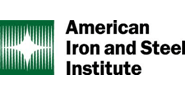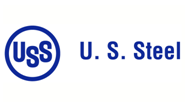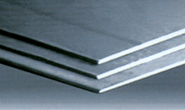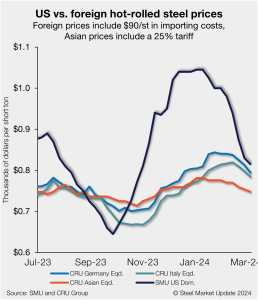
Ferrous scrap prices tumble in March
US ferrous scrap prices fell steeply in March for HMS, shredded, and prime scrap, sources told SMU.

US ferrous scrap prices fell steeply in March for HMS, shredded, and prime scrap, sources told SMU.
US steel exports jumped to 770,649 short tons (st) in January, rising 25% from the 12-month low recorded one month prior.

Estelle Tran, prices lead at CRU, Michael Cowden, managing editor at SMU and Josh Spoores, principal analyst at CRU, will be the featured speakers on a special CRU webinar. It will take place on Thursday, March 21, at 10 a.m. ET. You can learn more and register here.

Domestic production of raw steel inched higher last week, recovering after declining the week prior, according to the most recent data from the American Iron and Steel Institute (AISI).

As I see it, the market looked to be a perfect storm for consumers this month while two large steel mills tried to put a floor on hot-rolled coil (HRC). One source speculated that “flat rolled mills coordinated their downtime and will take out 250,000 tons of capacity in April,” which made them attempt to put a bottom on flat-rolled product.

U.S. Steel has announced an investment in Freespace Robotics, a Pittsburgh-based manufacturer of robotic storage and retrieval systems.

Reaction to the price announcements last week by domestic mills varied just a little depending on who you were speaking to. I heard rumblings before the announcements that a price hike of $100 per short ton (st) was coming. After the announcements were made, I had some questions as to whether they were increases at all.

In 2023, Mexico emerged as the largest trading partner with the United States—larger than Canada, and even China. The growth in trade with Mexico has been truly historic—Mexico has never captured the title of the largest exporter to the US. At $475 billion for the year, the value of US imports from Mexico exceeded that […]

The LME three-month price continued to strengthen through Friday, March 8, defending its position close to its five-week high and rising further to $2,262 per metric ton (mt), up 0.3%, on the day. Gains were also noted over the last week in other industrial metals, including copper, zinc, and lead. The price gains appeared to be due to weakness in the US dollar, which fell sharply against a basket of currencies after Fed Chairman Jerome Powell said on Wednesday that rate cuts were still expected this year.
The latest steel import license data from the US Commerce Department shows 2.39 million short tons (st) of steel entered the country in February 2024, down 6% from the month prior.

A weak start for sheet demand this year has continued to weigh on global prices. European demand outside of the renewable energy sector was weak enough that market participants said mills are likely to cut output further after several furnace restarts earlier in the year. In China, demand has also failed to pick up after recent holidays, and even government announcements of more stimulus measures during the country’s “Two Sessions” meetings failed to boost market confidence.

The premium plate prices have held over hot-rolled coil (HRC) are nowhere near recent highs seen in 2022 but remain higher compared to historical levels.

The US plate market has been largely quiet over the past week since Nucor’s $90-per-ton price cut at the close of February.

US and Canadian rig counts both eased this week, according to the latest release from Baker Hughes on Mar. 8. Recall that US rigs had reached a 5-month high last week.

The Dodge Momentum Index (DMI) slipped in February from the previous month, according to the latest Dodge Construction Network (DCN) data.

ArcelorMittal is targeting a minimum base price for hot-rolled (HR) coil of $825 per ton. The Luxembourg-based steelmaker said the new floor price was effective immediately in a letter to its commercial team dated Friday, March 8.

US steel mill shipments increased in January vs. December but fell from a year earlier,

A Detroit-area mill entered the scrap market on Thursday offering down $70 per gross ton (gt) on #1 busheling. And Nucor announced a minimum base price of $825 per short ton (st) for hot-rolled (HR) coil. What's the best way to interpret would could be read as contradictory trends?

Hot rolled (HR) futures have been on a bit of a hot streak recently, while busheling futures have been more in the “not” category.

At the request of Nippon Steel Corp. (NSC), the United Steelworkers (USW) union met with the Japanese steelmaker in person today to discuss Nippon's proposed acquisition of U.S. Steel.

Worthington Steel began trading publicly on New York Stock Exchange on Dec. 1. In one sense, this marked the “finish line” of the company’s separation process. As the company gets ready to release its first earnings report as a standalone company, president and CEO Geoff Gilmore reflected on the journey, and what lies ahead.

Antidumping and countervailing duty (AD/CVD) rates on imports of cut-to-length plate from two major South Korean producers may soon be adjusted.

The price premium cold-rolled coil (CRC) carries over hot-rolled coil (HRC) remains wide, according to our latest market check. Based on our steel price indices published Tuesday, the spread between these products is at the fifth-highest weekly level seen over the last 16 months.

Economic activity across the US increased marginally from early January through the end of February, according to the latest Beige Book report from the US Federal Reserve.

US hot-rolled coil (HRC) is now just about 5% more expensive than offshore hot band. The premium domestic product had over imports for roughly five months is all but gone, and nearing parity.

What are folks in the steel industry talking about at present? Respondents to SMU’s mini-survey this week shared some of their thoughts with us about what's going on in the market. Rather than summarizing their responses, here’s some of what they had to say in their own words.

India’s JSW Steel has selected steel industry veteran Robert Simon as CEO of JSW Steel USA.
AZZ – Precoat Metals has announced the promotion of Jeff Vellines to president of the company.

Flat-rolled steel prices have been running downhill in a hurry since the beginning of the year. In some ways, it's no surprise because other indicators have also been pointing lower for some time. Lead times have been contracting since the beginning of the year and are now below the five-week mark for hot-rolled (HR) coil for the first time since September. Mills are more willing to negotiate lower prices, and early reports seem to indicate that scrap might settle lower again in March.

Steel prices continued to ease lower throughout February, following a loss of upwards momentum in the middle of January.